 |
Spark Plug
Identification For Outboard Motors |
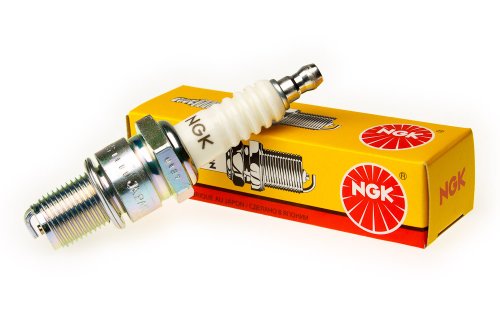 |
Spark plugs are the heart of having any motor run well (if
at all). Outboards
are even more so important if you have a Dead In The Water situation at a
critical time. And understanding their numbering system can be confusing to
the uninitiated (even to some of us who thought we knew).
Any old plug may fire and run your motor, but maybe not really well, EXCEPT if you put a longer reach plug in a head that requires a shorter reach. This will allow the piston to, on its upstroke hit and collapse the gap, creating a dead motor or at best one that does not run well.
Normally spark plugs are relatively cheap,
therefore it may be best to purchase and carry
spares of the proper version for your application. It's rather hard to
justify the loss of a week's vacation at a remote Canadian lake because your spark
plugs fouled, leaving you sitting on the shore wishing, and for only the cost of a
few dollars.
Spark plugs are made in different size threads and different
lengths of threads. For Champion, they have designations, of for
instance a J-6J would be a 14mm thread and a 3/8" reach (thread length, NOT
including the electrode) and a
medium cold heat range. The newer plugs could be a J-6C, meaning the
electrode was copper coated, for prolonged life. If the number had a
prefix R, like RJ-6C, that would indicate it was a resistor plug, designed to
eliminate electrical interference from the plug, mainly used on boats that are
equipped it a lot of electronics, (sonar, radio etc.)
A spark plug is said to be "hot" or "cold" by HOW WELL IT
DISPERSES HEAT, NOT HOW HOT THE SPARK IS, as
generally thought, but by keeping more heat IN, OR out by cooling the tip of the spark
plug. A spark plug is said to be "hot" if it can conduct more heat
out of the spark plug tip and LOWER the tip's temperature.
For a water cooled outboard motor that is otherwise well tuned, and in good shape BUT still fouls spark plugs, it would be advantageous to go to a COLDER range of spark plug, to burn off the fouling before it starts. This would especially be so if the motor was used for a lot of trolling. Air cooled motors which run at a HIGHER temperature require a hotter plug to cool the electrode and prolong longer plug life.
Colder plugs are ideal for small water cooled engines, where the
temperature inside the cylinder is low, as compared to other applications like
an air cooled motor that produces higher operating
temperatures. The water cooled need to retain much of
the heat to keep the internal temperature high,
which allows the plug to self clean and prevent fouling.
It
is important that to remember that a spark plug only functions completely
when its center electrode temperature is between these temperatures of about
500°C and 950°C.
The heat that the electrode
section of the spark plug receives due to combustion is dispersed through
the path in the illustration below, Provided by Densco
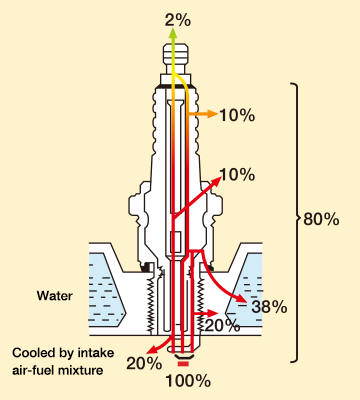
This is largely determined by the temperature
of the gas inside the combustion chamber and the spark plug design.
LOW HEAT RANGE AND HIGH HEAT REANGE
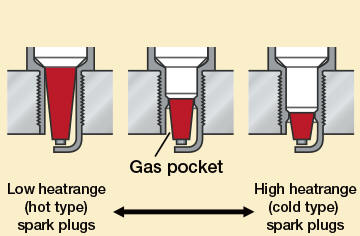
Low heat range plugs
have long insulator leg sections and the surface area affected by the flame
and the gas pocket capacity are large. Also, since the heat release
path from the insulator leg section to the housing is long, heat dispersal
is low and the temperature of the center electrode rises easily.
On the other
hand, high heat range plugs have short insulator legs and the surface area
affected by the flame and the gas pocket capacity are small. Also
since the heat release path from the insulator leg section to the housing is
short, heat dispersal is high and the temperature of the center electrode
does not rise easily.
As mentioned above, the thread length
does not include the electrode
LISTED BELOW
ARE GENERALLY USED CHAMPION OUTBOARD MOTOR SPARK PLUGS
|
Thread Size Reach |
Heat Range | Outboard type | Thread Size | Heat Range | Thread Length |
| 14mm 3/8" Reach |
HOT COLD |
H-10J J-12J J-11J J-8J J-7J J-6J J-4J J-2J |
7/16" 14mm 1/2" Reach |
HOT COLD |
L-9J L-7J L-4J |
| 14mm 1/2" 14mm 3/8" 14mm 1/2" 14mm 1/2" 14mm 3/4" |
HOT. . . Surface Gap |
RL82C J-19V L-20V L-19V N-19V |
14mm 14mm 14mm 14mm 5/8" Reach |
HOT COLD |
D-16J K-15J D-9J |
To check the
recommended spark plug for your OMC outboard,
CLICK HERE.
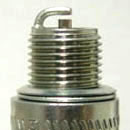 |
 |
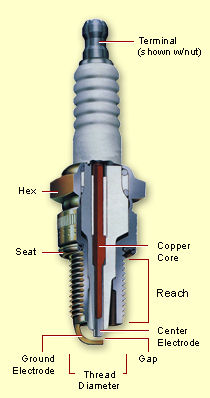 |
|
| The above illustrations came from Champion Spark Plug's website | |
Shown below is the Champion spark plug code system. This can help you identify what you have, and suitable replacement spark plugs
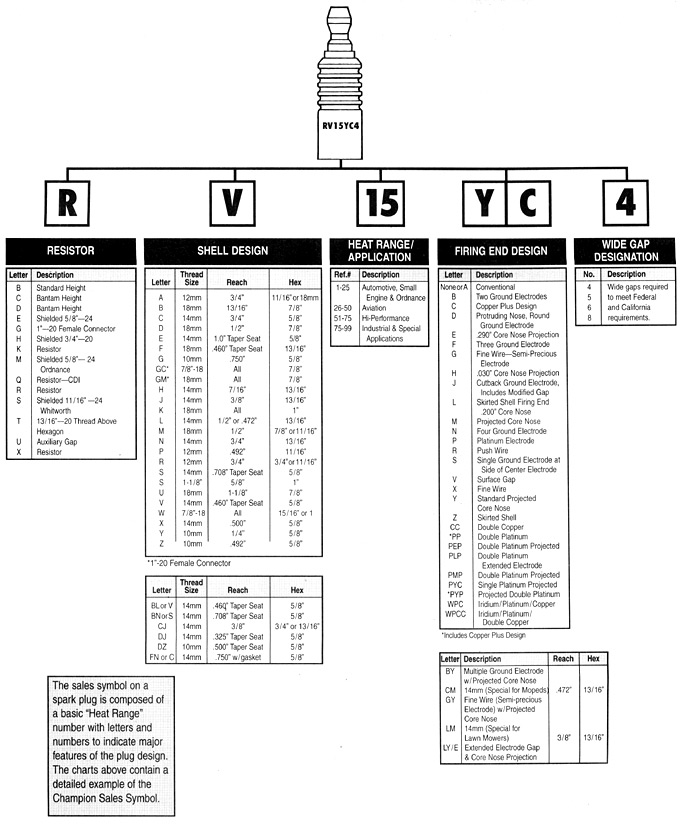
Shown below is a cross reference to other spark plug brands for heat ranges
You
will note that NGK's numbering system is reversed from Champion
Another thing to be aware of is that the non American made plugs "Reach" length
will be in millimeters and can be slightly different than the American made
versions. This may become a problem IF the foreign plug is long enough to
protrude inward to where the top of the piston will hit the electrode, smashing
it closed.
BELOW WAS COPIED OFF A OMC 9.9/15 MESSAGE BOARD
David Stanton All-star contributor
The NGK B7HS is for the 1974-1976 models with points,
and no electronic ignition, gapped at .030. The 1977 and up models with
electronic ignition should have BZ7HS-10. The -10 means it is made to have a
wider gap, and should be gapped at .040.
I run NGKs in all six of my 15 HPs and they all
run fine. I have worked on an early 9.9 for a neighbor and it wouldn't idle
good no matter what I did with the carb, timing, etc. using Champion plugs,
even Champion plugs that worked well in another motor. NGK B7HS cured the
idle problem. Several experts at the antique outboard club website have also
found that NGKs magically fix idle in some of these motors, but nobody can
explain why.
Now - to answer your question, hotter plugs will
probably not help your problem. Heat range of spark plugs has nothing to do
with how hot or how fast the motor runs or performs. It's all about the
temperature of the electrode tip in the plug to keep it from fouling. Hot
enough to burn off oil, etc., but not so hot that it causes pre-ignition
(knock/ping), which is like hitting the pistons with a hammer because the
gas ignites early (before the spark) from the hot plug tip and not from the
spark.
If your plugs aren't fouling bad, you have nothing
to gain by going to a hotter plug.
Note that if plugs are fouling bad, that could
also mean a carb problem making it run too rich. Is your motor new enough to
have the plastic-topped carb? And is that top cracked lengthwise along
the idle needle boss?
Also - be sure the mechanical spark advance with
the throttle is properly sync'd to the linkage that moves the carb throttle
plate - very important. Another thing to check - is your motor running on
one cylinder up to 15 MPH, and then the other kicks in? You could have
problems with ignition on one cylinder, or bad reeds, or crankcase pressure
leak on one cylinder's half of the crankcase.
David Stanton All-star contributor
Forgot to add that just about all 2-cycle outboards
have a speed a bit above high idle where they run rough. That is normal
because you are at a throttle point where the carb is transitioning from the
low speed needle to the fixed high speed jet, and it's in-between and
confused until you put the throttle high enough so most of the fuel is
coming from the high speed jet. This throttle band is usually narrow, but
you can easily take any of these motors and find that rough running throttle
setting.
CHAMPION (807M)
J-6JC (Copper) = (4122) BR7HS (Resister)
J-4JC =
BR8HS (colder
plug)
NGK B7HS (5110)
(non-coated) ---- BR7HS (7067) (Resister -
Iridium
coated)
BR7HS (4122) (Resister)
---- BR7HIX
(7067) ( Iridium coated)
Most all articles here are Copyrighted from 2013 to 2025 by LeeRoy Wisner
Back to the Main Ramblings Page
Originated 07-07-2013, Last updated 08-06-2025
Contact the author